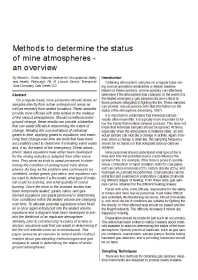Mining Publication: Methods to Determine the Status of Mine Atmospheres - an Overview
Original creation date: March 2006
Authors: RJ Timko, RL Derick
NIOSHTIC2 Number: 20031465
J Mine Vent Soc S Afr 2006 Apr-Jun; 59(2):46-55
Methods to Determine The Status of Mine Atmospheres - An Overview
NIOSHTIC2 Number: 20029906
2006 SME Annual Meeting and Exhibit, March 27-29, St. Louis, Missouri, preprint 06-062. Littleton, CO: Society for Mining, Metallurgy, and Exploration, Inc., 2006 Mar; :1-9
On a regular basis, mine personnel should obtain air samples directly from active underground areas as well as remotely from sealed locations. These samples provide mine officials with data relative to the makeup of the various atmospheres. Should conditions underground change, these results can provide a baseline that can assist officials in determining the extent of change. Relating the concentrations of individual gases to time, applying gases to equations, and examining their change-over time are tools that have been successfully used to determine if a heating event exists and, if so, the extent of the emergency. These atmospheric status equations have either been developed for the mining industry or adapted from other industries. They serve as tools to assist personnel in determining the condition of underground mine atmospheres. As long as the problem area continues to be ventilated, certain gases, gas ratios, and equations can be used to determine if a fire exists, what type of material could be burning, and what quantity of coal is burning. Once the mine or the involved section has been temporarily sealed, gases, ratios, and gas-derived equations can assist personnel in determining how conditions within the sealed volume are changing over time. To alleviate potential explosions when fresh air is once again introduced into the sealed volume, equations and a diagram have been developed to predict the likelihood of an explosive atmosphere. Similarly, prior to commencing recovery of a mine or section, equations exist that can assist in determining if the fire will rekindle when air is reintroduced. This paper serves as an overview to remind and/or instruct readers about gas-sampling methodologies and gas analyses to assist in determining the status of underground atmospheres.

NIOSHTIC2 Number: 20031465
J Mine Vent Soc S Afr 2006 Apr-Jun; 59(2):46-55
Methods to Determine The Status of Mine Atmospheres - An Overview
NIOSHTIC2 Number: 20029906
2006 SME Annual Meeting and Exhibit, March 27-29, St. Louis, Missouri, preprint 06-062. Littleton, CO: Society for Mining, Metallurgy, and Exploration, Inc., 2006 Mar; :1-9
- Comparison of Methane Concentrations at a Simulated Coal Mine Face During Bolting
- Evaluation of Sequential Extraction Procedures for Soluble and Insoluble Hexavalent Chromium Compounds in Workplace Air Samples
- Gas Sorption and Transport in Coals: A Poroelastic Medium Approach
- In-Mine Evaluation of Smart Mine Fire Sensor
- The Limiting Oxygen Concentration and Flammability Limits of Gases and Gas Mixtures
- Prediction of Longwall Methane Emissions: An Evaluation of the Influence of Mining Practices on Gas Emissions and Methane Control Systems
- Real-time Neural Network Application to Mine Fire - Nuisance Emissions Discrimination
- Reconciling Longwall Gob Gas Reservoirs and Venthole Production Performances Using Multiple Rate Drawdown Well Test Analysis
- Sonic Anemometer Airflow Monitoring Technique for Use in Underground Mines
- Use of Vacutainers for Collection of Mine Atmosphere Samples